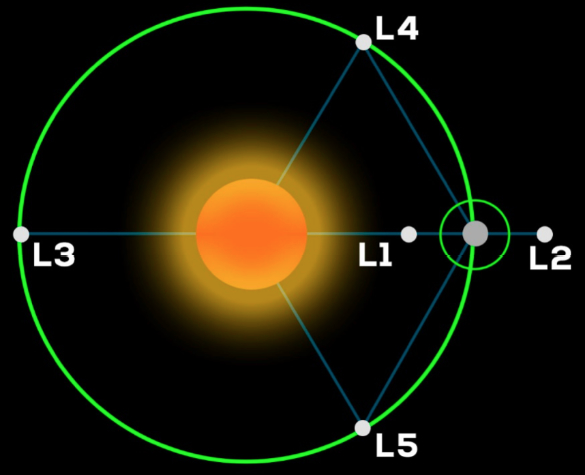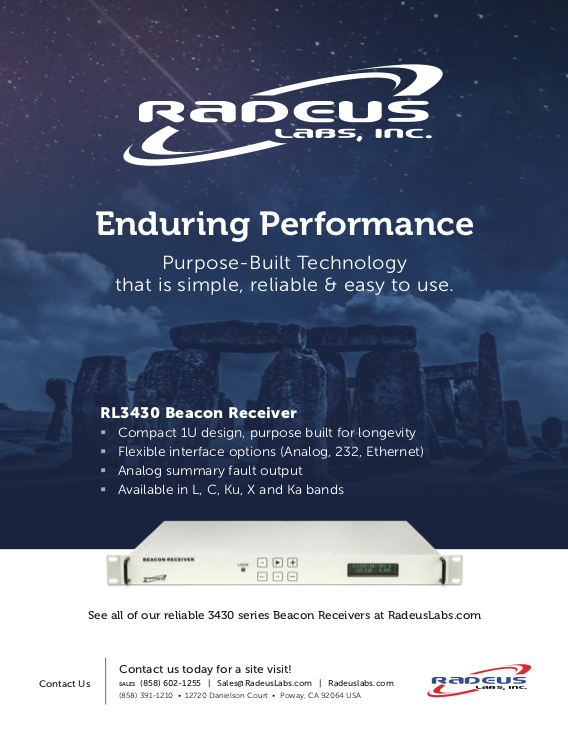Merely decades ago, just getting from Earth to the Moon and back was enough.
Today, many space-faring nations have set their sights on exploring and developing the area of space in between – cislunar space – as a possible stepping stone to future space exploration and development. “Cislunar” refers to the volume of space influenced by the Earth and/or Moon. Geosynchronous orbit — typically the highest orbit for satellites — is approximately 22,236 miles above Earth’s equator. The moon lies approximately nine times that distance — 238,900 miles — from Earth.
The National Aeronautics and Space Administration’s (NASA) Artemis program is planning to return humans to the moon by 2024, and to build an orbital outpost, known as the Gateway, in the vicinity of the moon during this decade. The Gateway could enable human-crewed missions in cislunar space and missions on the surface of the moon, as well as demonstration projects for technology to be used for Mars and other deep space missions.
At the same time, China and Russia are working together on plans for a joint International Lunar Research Station, a planned lunar base.

George Pollock
“There are a number of factors which are driving the marked increase of interest in cislunar,” said George Pollock, director of the astrodynamics center at the Aerospace Corporation, the only federally funded research and development center dedicated to serving the entire U.S. space enterprise.
“First, you have the scientific interests. The Apollo missions answered many questions about the moon and its origins, but also posed other questions,” Pollock said. “Perhaps the most tantalizing of those questions is the indication from orbital sensors that there could be substantial volumes of water ice in various locations on the moon and that’s one of several potential resources that could be used for expanding humanity’s exploration of the solar system. If you’ve got water, you’ve got hydrogen and oxygen, which could be used as rocket propellant.”
“One objective that NASA has in mind, is that going back to the moon is a stepping stone to getting to Mars with humans,” Pollock added. “It serves as a test bed for key technologies that will be needed for those longer-duration human spaceflight missions to Mars and beyond.”
“And then there is an interest globally, motivated by international prominence or prestige – the presence of robotic spacecraft and human activities on and near the moon stand to represent the culmination of human ingenuity and technological supremacy and serve as foundational evidence that a nation is a space- faring leader,” Pollock said.
“Then there’s national security. As a nation’s interests expand beyond GEO, there are national security motivations for understanding the earth-moon system and ensuring that they can secure their interests,” Pollock said.

Bruce McClintock
“Another factor driving the interest in cislunar is the fact that technology has finally advanced enough to make it practical,” said Bruce McClintock, lead for the RAND Corporation’s Space Enterprise Initiative and senior policy analyst. In cislunar space, any space object must contend not only with the effects of Earth’s gravity, but also that of the moon’s, which affects everything from a rocket’s trajectory to the kind of orbit it might have around the moon – and how those orbits change over time. Scientists have known for centuries about some of the unique orbital mechanics of cislunar space – including the five Lagrange points, positions in space where gravitational forces create a sort of “parking space” for objects where they tend to stay put – but it’s only been in the last 50 years that humanity has been able to use them for space operations.

As examples of using similar Lagrange point
locations in the Earth-Sun system, L1 is where
the Solar and Heliospheric Observatory
Satellite is located, and the L2 point will be the
future home of the James Webb Space
Telescope,according to NASA.

Jan Osburg
“Over the past several years, there has been a significant change in capabilities, as far as reliable, low-cost space launch is concerned,” said Jan Osburg, senior engineer with RAND, a nonprofit research organization. “For the longest time, there was no point in the United States and the DoD worrying about what should or could we do on or around the moon, because there was no way to get there for any sort of reasonable amount of money and risk. Humanity was pretty much stuck in Earth orbit up to the GEO belt.”
“One of the under-appreciated realities of beyond-GEO spaceflight is that the orbital dynamics become much more rich,” Pollock explained. “Once you get out there with your spacecraft, you’re able to do maneuvers that would be unthinkably expensive in a direct Earth orbit. There are halo orbits on, say, the far side of the moon and the near side of the moon and one can transfer between those for a very small amount of propellant.”
Cislunar orbits could be used for multi-purpose orbiting platforms, propellant storage depots, research outposts, places to extract and process extraterrestrial minerals, Pollock said.
The role Space Systems Command and the USSF will play as humanity expands into cislunar space is still evolving. A recent memorandum of understanding between the NASA and the U.S. Space Force noted that USSF’s “sphere of interest” extends beyond GEO – “more than a tenfold increase in range and 1,000-fold expansion in service volume. USSF now has an even greater surveillance task for space domain awareness (SDA) in that region…”

Frederick Palkovic
“You can think about cislunar space in a similar way as we view other domains,” said Frederick Palkovic, deputy chief of SSC’s space domain awareness division.
“For example, in the sea domain we don’t need to know everything going on, everywhere, in all the oceans. What is important to know is the right things at the right times and right locations necessary to support our national interests including the protection and defense of our sea lines of communication. To know everything, everywhere, in our oceans might be nice but it is simply unaffordable.”
“Today in the space domain, we have systems of systems which work together to gain and maintain space situational awareness in the critical orbits around the Earth,” Palkovic said. “In general, we use radars to illuminate objects in near earth orbit to track satellites and debris close to the earth and use optical systems using the energy from the sun reflected off satellites to track objects in the geosynchronous belt.”
“While our current systems have provided us with domain awareness in the past, the expansion of our national interests into cislunar space is a 1,000 times increase in the volume of space to maintain awareness of,” Palkovic said. “The key here remains the same as our needs in near earth space and in other domains: to know the right things at the right times.”
What are our national interests in cislunar space? Palkovic explained, “Well, there will be much debate before that is settled, but, the guiding principles are fundamental and not likely to be changed. We need to know enough to protect our national interests in space and ensure potential adversaries do not use the sanctuary of the dark of deep space to threaten our national interests there, closer to earth, or in the other domains.”
“SSC’s anticipated future role is to deliver systems capable of providing cislunar domain awareness, commensurate to U.S. national interests,” Palkovic said. Already, SSC participates with a broad team looking at the challenges of cislunar space, including SSC’s federally funded research and development centers and laboratory partners, USSF, U.S. Space Command, NASA, the intelligence community as well as international and commercial space industry partners.
In addition to expanding space domain awareness into cislunar, space-faring nations also will be dealing with another issue: there is no GPS in cislunar space.
“The current situation is that our globally position-navigation- and-timing systems are space utilities,” Pollock noted. “For operations that go beyond GEO, it’s typically been incumbent on the operator of the system to provide their own navigation solution, usually by leveraging their two-way communications link to do so. We don’t have a globally available utility like we enjoy with GPS today. As activity increases beyond GEO, it may well become worth the investment to provide an interoperable user service such that spacecraft operators can get PNT on demand at a lower cost.”
Further defining space norms and “best practices” is another policy challenge to be sorted. The 1967 Outer Space Treaty, with more than 100 signatory nations, is a foundational set of international agreements about the use of space, Pollock said, but it will be necessary to add more specificity as to what exactly constitutes good or bad behavior in space.
NASA’s Artemis Accords, which 12 countries - Australia, Brazil, Canada, Italy, Japan, Luxembourg, New Zealand, the Republic of Korea, Ukraine, the United Arab Emirates, the United Kingdom and the United States - have signed, covers such principles as peaceful exploration, registration of space objects, release of scientific data, extracting and using space resources and the deconfliction of activities.
For example, while no nation can lay claim to a celestial body, what happens when different nations want to start mining rare minerals from the moon? How do countries make sure space debris doesn’t become an issue around the moon, as it has in Low Earth Orbit (LEO)? While Pollock said the “preferred” cislunar orbits are large enough that it will be a long time before crowding becomes an issue, there may be problems with inadvertent communications interference that will need to be worked out.
“Cislunar is not something that’s going to dramatically escalate overnight,” McClintock said. “We’ve been operating in space since the 70s with a small number of platforms – it’s going to take time to expand to the point where it’s something that’s considered a common occurrence. But we are starting to see more activity there, and we need to take note. The United States can’t just wait until things are fully mature there – otherwise we will have fallen too far behind to catch up.”
Want to learn more? Check out these resources:
Aerospace: Cislunar Stewardship: Planning For Sustainability and International Cooperation
Aerospace: Cislunar Development: What to Build—and Why
Air Force Research Laboratory: “A Primer on Cislunar Space”
NASA: The Artemis Accords
The Outer Space Treaty
RAND Corporation: “A Clean Sheet Approach to Space Acquisition in Light of the New Space Force.”
Space Force Journal: Cislunar Mission Concepts for the Space Force Journal: Cis Department of Defense


